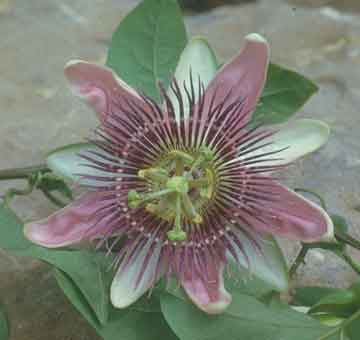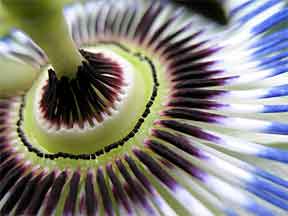Passion Flowers (Passiflora), delightfully different old world vines are staging a comeback. These easy to grow plants with their starry jewel like flowers make top notch pot plants as well as handsome climbers for the outdoor garden landscape.
Sixteenth century monks began the association of passion flowers with the passion of our Lord. The fancied resemblance of the central parts of the flower to the cross, the hammer, crown of thorns and ten apostles gave rise to the name passion flower. In Italy and Belgium it was in cultivation as early as 1609.
Examination of a single bloom will show you why it was easy to weave legends about them. The ten parts of the floral envelope (five sepals, five petals) supposedly represent the ten apostles present at the crucifixion with Peter and Judas being absent. Representing the crown of thorns is the corona of colored thread-like filaments or fringes. The five stamens are suggestive of the five wounds while the three styles are thought to depict the three nails.

Although some three hundred species and varieties of Passifloraceae have been discovered, few remain in cultivation. However, a few nurseries and greenhouses do carry some of them. If you cannot purchase a complete plant you may be able to talk the nurseryman into selling you a cutting. That’s how I got my first passion flower. In early February I picked up a small 3″ inch cutting of Passiflora caerulea and by mid-July it was a 12′ foot giant covering an outdoor trellis.
Cuttings root easily in water, sand, good potting soil or vermiculite. As soon as a cutting is well rooted, pot up into a 3″ inch pot of good potting soil or any of the specially prepared soils you use for African violets. Give it a sunny window such as an east or south exposure, daytime temperatures of 72-80 degrees with a drop of ten degrees at night, and you’ll be rewarded with a rapid growing vine.
Within 6 to 8 weeks you’ll have to shift the vine into a 4 or 6 inch pot, and as soon as any anger of frost is past you can plant it into the outdoor garden.
Plunge the pot into the garden or remove the passion vine and plant directly into the soil. If you set the plant into the soil restrict its roots with metal, plastic, or treated wood to encourage flowering.
In our area, passion flowers are not hardy. A weedy sort, Passiflora incarnate (maypop) and the yellow-flowered Passiflora lutea are hardy in the South and some parts of the west.
In the fall pot up the old vine and cut it back to eight or ten inches before placing it in the window garden. Growth is slow during November and December but after the first of the year the vine grows rapidly and produces an array of waxy flowers.

If you cannot purchase a plant or cutting try growing some from seed. Even small seed houses usually offer one or two varieties and specialized dealers list many more. Sow the seeds in February or March in a large pot or flat of light soil. Keep slightly moistened and in 60-65 degree temperatures. Seeds are variable as to germination with some showing sprouts in three weeks – others taking as long as three months to germinate.
When the plants show 4 good leaves pot them into 3″ inch pots of soil that recommended for growing cuttings. As they mature they will require shifts into 4 and 6″ inch pots. Seedlings produce a few flowers the first year and a heavy floral crop the second year.
About the only pests to bother indoor grown passion flowers are red spiders. Symptoms are rust or near yellow spots on leaves, with the entire leaf soon yellowing and falling off. Treat infested plants with natural neem oil as a pesticide and you will make short work of the pests.
Passiflora caerulea is the most commonly grown. Its faintly perfumed flowers are about three inches across with pale green petals and sepals making a base for the double row of sapphire blue and white corona filaments. A column of three blue-tinged styles rises out of flower center.
Purple and white Passiflora adulis has the added attraction of bearing edible purple fruit.
And for the landscape gardener who desires pink flowers there is Passiflora mollissima with fringed rosy-pink flowers. If you enjoy these plants and wish to collect them you’ll discover handsome red-flowered sorts such as Passiflora manicata and some hybrid forms – lavender-flowered Passiflora rubra and Passiflora maliformes with wine and white speckled filaments.
